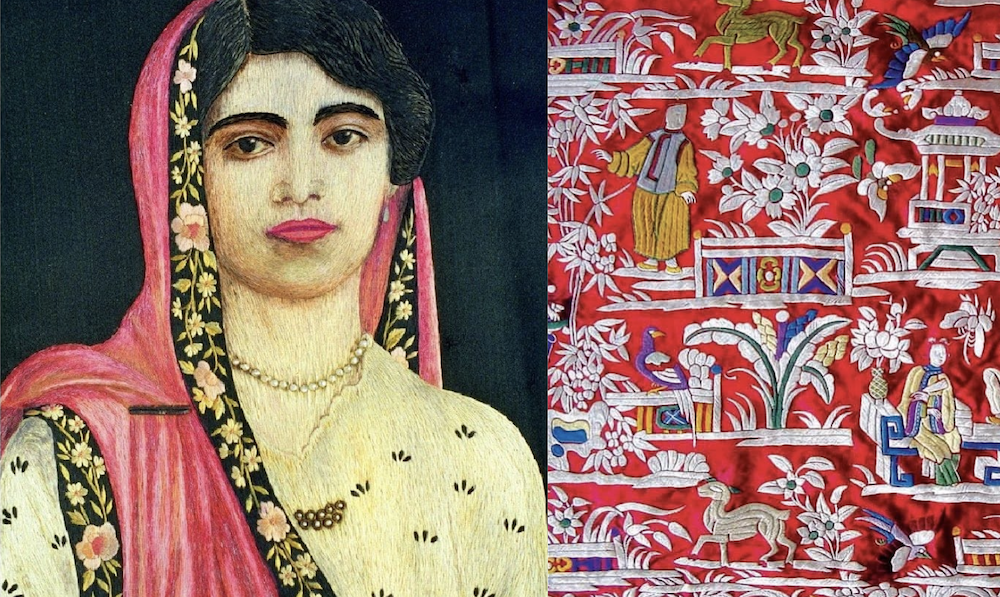Smriti Malhotra
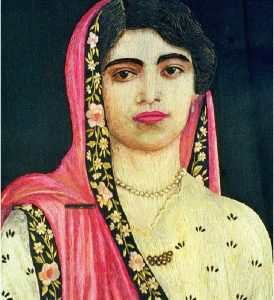
Textiles have played a significant role in the trading practices between countries since the beginning of time. Our Indian textiles such as double ikat patola have been traded to far away islands of Indonesia, Indian chintz & Kashmiri shawls to Europe, but in this article we shall be talking about a beautiful embroidered textile that we got through our trade with China. The trading practices between India and China had led to the addition of Chinese embroidery in the vast pantheon of Indian embroidery, in particular in Parsi embroidery, which is called the Gara embroidery. Parsi traditional attire is incomplete without some gara embroidered pieces.
Parsis are known to be ardent admirers of all things intricate and something that may be reflective of their culture and history. The gara isn’t a sacred or ritualistic clothing item, but is found in the trousseau in all Parsi households and worn by its people to all Parsi functions and for the Parsi celebration of Navjote.
Made by the Chinese embroiderers, traded under the British rule, brought here by Parsi people of Iranian origin, the garas reflect an intercultural amalgamation of various influences. Stemming from traditions, the garas is a unique innovative piece that is continuously changing and evolving. One of the most beautiful aspects of Gara embroidery is its adaptability. The Gara found its origins in Chinese embroidery, dabbled in European as well as Indian embroidery. And reflecting the diverse influences such as Indian, Iranian, Chinese and European.
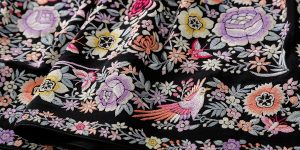
Parsis have saved these beautiful embroideries as a part of their precious history in the form of Gara saris. Though some of the Chinese embroideries are still practised now, the craftsmanship can’t match the ones originally made by the Chinese artisans. Garas have now become heirlooms for the Parsi ladies, passed down in their family, given to daughters and daughter in laws at the time of marriage. Garas from the time of their inception found a special place in the Parsi culture.
To understand the trading story of this beautiful textile tradition, we have to understand the history of Parsis and their arrival in India and touch upon the elements of Zoroastrianism.
Zoroastrianism and their arrival in India:
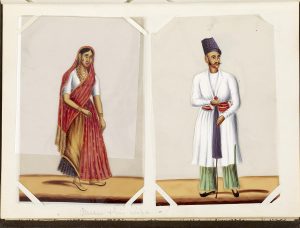
Zoroastrianism or Zoroastrians as they are still called in places outside India were the first monolithic faith in the world. It is such an ancient religion that the exact date of their prophet – Zarathustra or Zoroaster (in Greek) is not known. Second important personality in Parsis history was Cyrus (550-529 B.C) who laid the foundation for Persian polity. Under him and his successors, the Persian Empire became the most powerful state in the world until its conquest two centuries later by Alexander the Great.
But it was in the Sasanian period (224 – 651 AD), that Zoroastrianism became an organised state religion. But after the conquests of the Arabs, and the establishment of the Muslim hegemony, the Zoroastrian empire came to an end. Many Persians took up Islamic faith under pressure and most left their homes and fled. They travelled to the Deserts of Iran, in smaller cities such as Yazd, where they can still be found. Since the Zoroastrians were always traders, they also found refuge in Sajan, on the west coast of Gujarat, marking their entry into this country.
Zoroastrians in Gujarat started to be referred to as Parsis and started to make this country and this land their new home. Soon, they moved to Surat and started looking for professions, they became master weavers and shipbuilders. When Surat lost its commercial prominence, the Parsi began to migrate to Bombay thereafter. According to legends, the first Parsi resident was Darabji Nanabhai, arriving in 1640 and doing business with Portuguese once the power was shifted to the English East India company, he started working for them. Bombay was rapidly changing into the East India Company’s trading centre.
Trade relations with China:
East India Company had solid trade relations with China, two major commodities traded were cotton and opium. East India finally found a commodity that the Chinese would accept instead of silver. A three-sided trade began between British India and China, in which Indian cloth was sold in China, money from which bought tea that went to britain. Opium was included last in this trade after the East India Company gained a monopoly over opium production in Bengal. Since the import of opium was illegal in China, they sourced the job out to Parsis and Marwaris. The huge profit made in the China trade enabled the Parsis to be affluent and rise up the ranks. They now played a key role in all spheres – social, financial, cultural & political. Within a few years, many Parsi traders were travelling between India and China, and many started living in the country too. It is said that Parsi women asked the Chinese artisans to embroiders their saris and trousseau in their traditional embroideries.
According to a popular legend, a Parsi trader living in Canton requested a Chinese embroiderer to make a 6-yard long sari for his wife back in India. These first few pieces aren’t finished properly, they look like yardage with no border and palluv. That is how one of the earliest Chinese embroidered garas came to our shores. They had the Buddhist and Taoist symbols and motifs embroidered on them such as the divine fungus, mythical creatures, etc. Embroidery is considered to be a sacred art in China, because China has such a long tradition of embroidering, and it is done painstakingly.
Parsis involvement with the Chinese soon began to decline after the 1930s. Due to the Sino-Japanese War, Indian independence in 1947, and other political events thereafter, put an end to the Parsis trading relations with China.
Parsi Garments and embroidery:
Not much is known of the Parsi textile trousseau before the 18th century, and the gara embroidered sarees and pieces only came into the picture once they adopted the sari after their arrival in India. Besides that they have the Jhablas (a long tunic, mostly made for children),Ijars (a loose trouser can be worn by any gender and has a cord at the waist that can be tightened like Indian salwars) and kusti and sudreh (sacred clothing worn beneath all clothes by Parsis and Zoroastrians for important ceremonies.
Coming to the different garas found in the Parsi textile trousseau, they are well-categorised on the basis of their designs and layout:
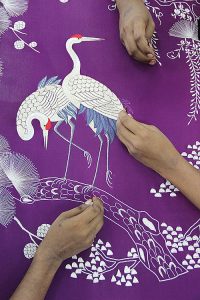
Garas can be categorised on the basis of their layout and designs :
- The earliest kind of garas were 5 metre pieces cut from readily available embroidered cloth, often called ‘dorpat sari’, ‘dor’ coming from Gujarati ‘dodh’ meaning one and a half and ‘pat’ referring to ‘patta’ a strip of cloth. These dorpats would be joined together to make a 120 cm width sari.
- Akha garas or the ‘full garas’, whereby the entire piece is embroidered, and very little of the base is visible to the eye, only the areas to be tucked were excluded. These were especially made to be worn as a sari.
- Kor- pallav garas, where the palluv is elaborately embroidered, matching the designs on the borders.
- Kor ni sari, where only the border is sewn onto the sari.
- New names had also been added to this list, like the Cheena- Cheeni sari, depicting the embroidered Chinese figures and their lifestyle and culture. A pair of birds on branches were a common motif on these garas; they are called chakla-chakli no garo. Chakla means ‘sparrow’, but the name was given to any gara with a pair of birds. These garas got their name from the motifs that were embroidered on them. Another such gara is kanda-papeta no garo (onions-potatoes)
Different embroideries were employed by the Chinese artisan to make these uniquely named garas such as petit point embroidery, mochi and aari embroidery and Zardozi and zari embroidery that was picked up by the Parsi ladies themselves once they moved to the Deccan region. Different stitches such as satin, voided, embossed, long and short stitches, overlaid and crouching stitches were used in the traditional garas.
The patterns and motifs that were traditionally getting embroidered by the Chinese artisans were from a set design book that was quintessentially Chinese and reflected the Chinese culture and ethnicity, but new design patterns also emerged that was made for trade and that became a hit amongst foreigners and that exoticised the land just perfectly. Some of the common Chinese motifs that were depicted on the garas were:
- Chrysanthemum, plums, peonies, and lotuses depicted together represent the different seasons of winter, spring, summer and autumn.
- Chakla-Chakli designs, which also gives the name to its gara – chakla-chakli no garo, it depicts a pair of birds perched on a branch facing each other or in the same direction. They are of the opposite sexes signifying a harmonious marital life and happiness.
- Cheena – Cheena no garo : It is showcasing the everyday life of the Chinese man, representing a far off exotic land. Depicting the abundance of trees, Chinese architecture, people involved in their daily activities to give the foreigner a glimpse into the Chinese lifestyle and way of living, presenting the viewers with a different world altogether.
- Birds are abundantly represented on Garas, the peacocks, roosters, pheasants, magical and mythical birds like the phoenixes, many of them are loosely called the birds of paradise, because of their long and elegant tail feathers. The phoenix motif is a Chinese representation also found on Parsi garas made by Chinese embroiderers. Beautifully depicted, with head like a pheasant, parrots beak, ruffled feathers, tail of a peacock and legs of a crane.
- Persian motifs like the simurgh, can be seen on the Parsi gara, considered to be sacred bird, bearer of light after darkness, providing protection and health. It is an emblem of power and purity. Similarly rooster is a sacred bird in Persian and Zoroastrian dictionary, its crowing slays the demon (darkness) and brings light into the world. Fish is also another motif derived from the Zoroastrian culture, which means prosperity, and protection for the Parsis; it represents abundance. That is why fish is always a part of all Parsi/Zoroastrian rituals and auspicious functions.
- Peacock, a motif coming from India, is a favourite of chinese embroidery, liked for its beauty and elegance. This has been seen on a lot of chinese embroidered garas, but not the ones made by the Parsi ladies after that. As the peacock though beautifully depicted is considered evil and inauspicious. The Parsis believe the peacock/feathers represent the evil eye.
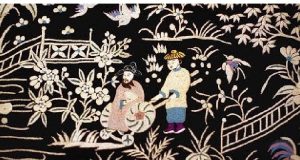
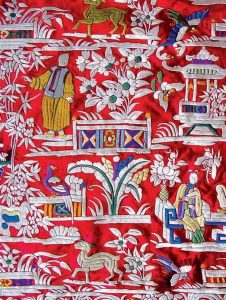
Besides these common motifs, there were European influences as well such as ribbons, peonies, scallops, bows, and even the Indian paisleys.
The traditional gara embroidery now ceases to exist with just a handful of Parsis engaging in the craft of making them. However, there are families that are trying to restore old gara embroidery saris. There are Parsi designers who specialise in using the gara embroidery in a contemporary manner. Designers such as Ashdeen are reviving the embroidery and modernising a traditional embroidery style that could have gone out of vogue ages ago!
Ratan Tata Industrial Institute in Mumbai also took part in this revival movement in the mid twentieth century, starting by making new garas in traditional embroidery. Another organisation who took part in this initiative in recent times is the UNESCO Parzor Organisation. Among its many projects is the Parzor project of preserving and promoting Parsi Zoroastrian Culture and Heritage.
A lesser known textile, the gara represents a beautiful amalgamation of Chinese, European and Persian influences. It represents the cross-cultural union between two nations that showcases the importance of textiles and traditions transcending boundaries and ethnicities. Gara is a textile piece that harbours many stories of faraway lands, while distinct yet very similar to our own, implying the universality that binds us all. It’s worthy of being known and popular, and saved from the extinction that they may slowly be inching towards. Gara is a true global textile merging eastern sensibilities with that of the west. A dynamic textile that stems from tradition and moves towards new ideas, fabrics, stitches and motifs. It is fluid and adaptable in nature, the garo has come a long way from just being a Chinese embroidered yardage to a beautiful 6 yard Parsi sari. A treat to the eyes, representing a delightful visual narrative suggestive of its own history and past.
This traded textile has come a long way, and is now an essential part of an entire community, a defining component in Parsi culture. So much so, that a chinese embroidered piece gained relevance and popularity in our nation by the name of the community who adopted it, and wears them. It is no longer just a gara sari, it is the parsi gara. Garas style reflects the refined taste, and style of the Parsi ladies who wear them, unlike any other garment. It is a story within itself, worn proudly and admiringly by Parsi ladies. A much loved item of clothing, that will not be going away any time.
References:
- Shah Shilpa and Tulsi Vatsal: Peonies & Pagodas, Embroidered Parsi Textiles – Tapi Collection, Garden Silk Mills Limited, 2011.
- Cama Shernaz : Threads of Continuity: Zoroastrian Life and Culture, UNESCO Parzor Foundation, 2016. Exhibition Catalogue.

